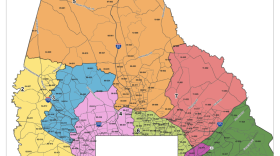Baltimore County now has a map it will use to expand the county council from seven to nine seats in time for the 2026 election.
The new map creates two majority Black districts on the county’s west side. It also has a third west side district in which a majority of its residents are people of color, known as a minority-majority district.
The other six council districts will be majority white.
“It really creates an opportunity to have three minority members join this council in 2026,” said Councilman Izzy Patoka, a Democrat who consponsored the legislation that created the map.
The current seven-member council has only one Black member, even though the county is about 30 percent African American and nearly half its population are people of color.
The council passed the map Monday on a 5-2 vote. Democrats Julian Jones and Pat Young voted against it.
Opponents attacked that map on two fronts.
They argued there needs to be a fourth district in which a majority of the residents are people of color to take into account the county’s growing diversity on the east side.
“I don’t think that we’ve gone far enough by recognizing what our county looks like now in 2025,” Young said.
The council voted down a proposal by Young to go back to a map that had been approved by the council’s redistricting commission. That map included a fourth minority-majority district on the east side.
Others said the council went too far creating the third minority-majority district on the west side. They said by shifting African American voters into that district, it weakened their grip on the two majority Black districts.
Jones, who is African-American, said the creation of that third district was disrespectful to him and his constituents because it divides up communities between council districts.
“My constituents do not want their communities split up just like everybody else,” Jones said.
Jones proposed that the council delay its vote on a final map so they could take more time to consider amendments. That was rejected.
Councilman Todd Crandell, a Republican, said the council did itself a disservice by allowing the redistricting process to become so racially divisive.
“We advocate to fix potholes,” Crandell said. “There are very few decisions on this dais that have run along ideological lines.”
Crandell and his two fellow Republicans, David Marks and Wade Kach, were key to getting a map passed on the seven member council because a supermajority of at least five votes was needed. They rejected the redistricting commission’s original map with four white minority districts as being too partisan.
The last time the council passed a new map, in 2021, it was sued by the American Civil Liberties Union of Maryland, the NAACP and others. The organization made its intention to sue the county known minutes after the vote.
This time is different.
At a rally preceding Monday night’s vote, Nehemiah Bester, a communications strategist for the ACLU, was asked if the organization was poised to sue the council again.
“Our lawyers are looking into it,” Bester said.









